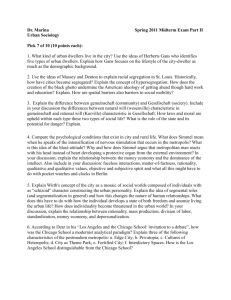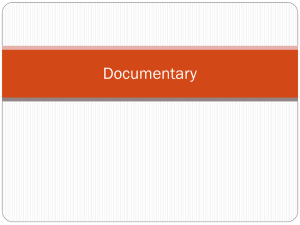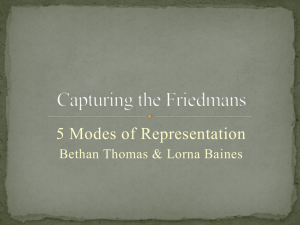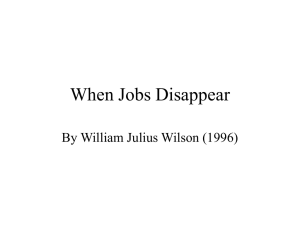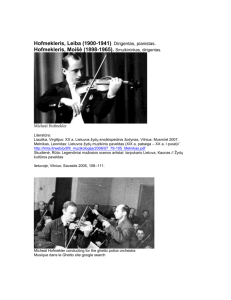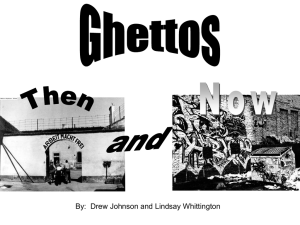Radio Documentary and Podcasting
advertisement
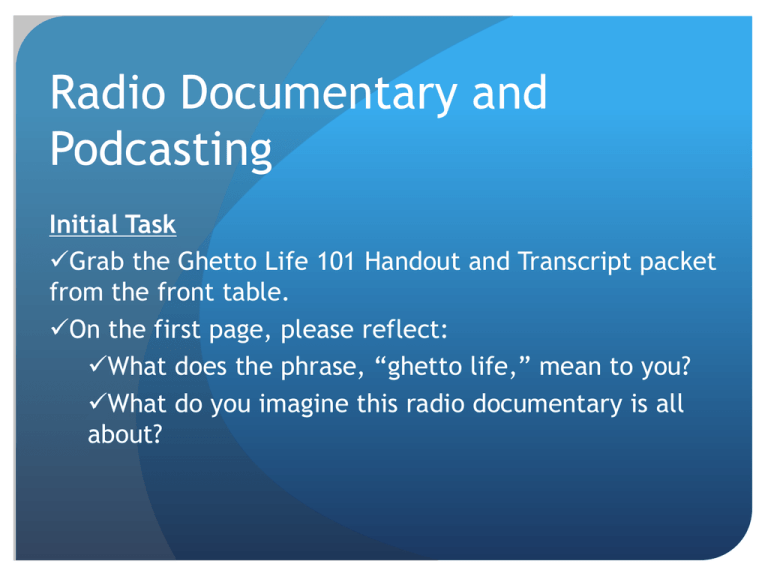
Radio Documentary and Podcasting Initial Task Grab the Ghetto Life 101 Handout and Transcript packet from the front table. On the first page, please reflect: What does the phrase, “ghetto life,” mean to you? What do you imagine this radio documentary is all about? Monday’s Game Plan Learning Objectives/Goals Today’s Tasks Develop an understanding of the term, “radio documentary.” New Unit! Radio Documentary and Podcasting Practice active listening, analysis, reflection, and discussion in context of the selected media text. Respond to text critically; applying your personal experiences to your understanding of the documentary. What is radio documentary? Intro to Ghetto Life 101. Pre-listening reflection and discussion activity Begin active listening and responding to Ghetto Life 101. What is radio documentary? A radio documentary or feature is a program devoted to covering a particular topic in depth, usually with a mixture of commentary and sound pictures. What do you think a sound picture is? Some radio features, especially those including specially composed music or other pieces of audio art, resemble radio drama in many way, though often non-fictional in subject matter. What is non-fictional? Other radio documentaries consist of more straightforward, journalistic-type reporting – but at much greater length than found in an ordinary news report. (definitions adapted from wikipedia) What’s Ghetto Life 101? Two 13 year-old boys from Chicago- LeAlan Jones and Lloyd Newmancreated the radio documentary. Ghetto Life 101 tells about their lives and their neighborhood. The idea for GHETTO LIFE 101 came from David Isay, a New York writer. He was asked to make a documentary for a public radio station in Chicago as part of a series on issues of race and ethnicity in the city. Instead of interviewing scholars and other experts on urban life, Isay decided to ask young people who lived in urban neighborhoods to tell their own stories. After receiving dozens of responses from interested young people, Isay hired Jones and Newman as reporters, because “they were smart. They were funny. They were the ones.” What’s Ghetto Life 101? LeAlan Jones and Lloyd Newman decided to speak frankly about themselves, their families, and their community. They chose to share not only the good things about their lives but also their sorrows, fears, and disappointments. To broaden their audience’s perspective, they interviewed relatives, teachers, classmates, and others in their neighborhood- the area around the Ida B. Wells, a housing project on the South Side of Chicago. Lloyd Newman and his family have an apartment there. LeAlan Jones lives in a house nearby. Ida B. Wells Housing Project, 2003 Photo by John Brooks Ida B. Wells Housing Project, 2003 Photo by John Brooks Ida B. Wells Housing Project, 2003 Photo by John Brooks. Pre-listening questions and discussion A major theme in Ghetto Life 101 is community and neighborhood. LeAlan Jones suggests that outsiders know very little about his community. Do you think he is right? Do people who live outside the “ghetto” know about what life is like within that community? How much do you and your friends know about neighborhoods other than your own? How do you get information about the people who live in other neighborhoods? What part does the media play in shaping your impressions of people you’ve never met? How else did you acquire those impressions? How do people in other neighborhoods learn about you and your friends? Ghetto Life 101: Critical Listening We are going to listen to the entire radio documentary at least twice over the next couple of days. As you are listening, consider what message the boys want to communicate in their radio documentary. Use the Ghetto Life 101 Critical Listening handout to guide your note-taking and reflections. You are also encouraged to follow along on the transcript and highlight dialogue and incidents that stand out to you. What’s ahead: Tomorrow: Finish initial listening and questions. Begin 2nd listening session. Remember to follow along on transcript. Highlight and/or mark moments, interviews, and incidents that stand out to you.
